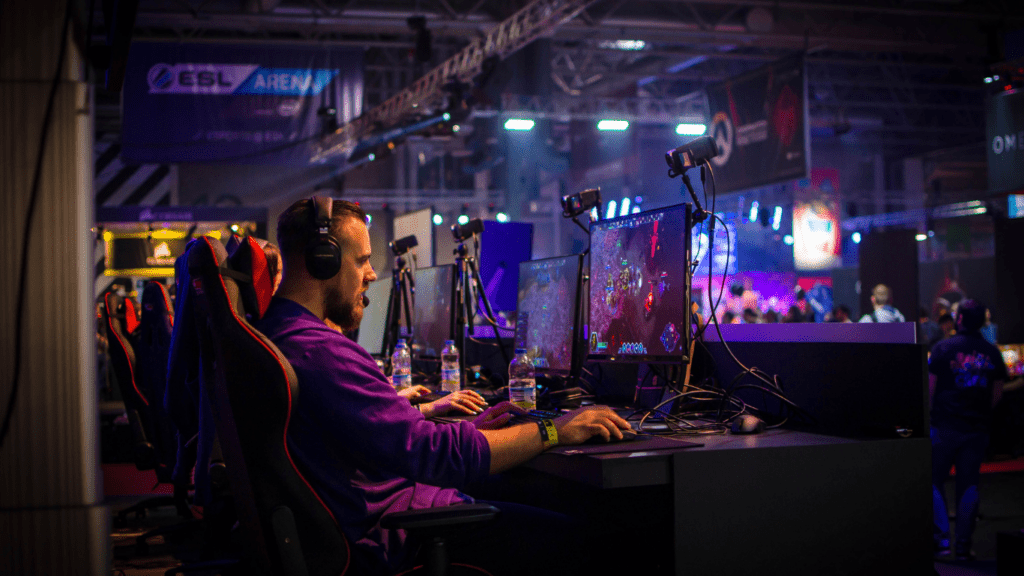The Evolution of Esports
Competitive gaming’s evolution began with classic arcade tournaments in the ’80s, where players gathered to test their skills on titles like Pac-Man and Space Invaders. With technology advances, the ’90s saw the birth of PC and console esports with games such as Quake and StarCraft making waves in LAN parties and early online competitions. This period set the groundwork for the infrastructure seen in modern esports.
During the early 2000s, broadband internet significantly influenced esports, enabling widespread global participation. Online platforms like Twitch and YouTube revolutionized how audiences consumed esports, transforming matches into live broadcast events. Unlike earlier formats, fans could now engage with players directly, fostering a new esports community.
The 2010s brought livestreaming and social media proliferation, allowing esports to reach wider audiences at unprecedented scales. Games like League of Legends and Dota 2 spearheaded an era of organized competitive leagues and multimillion-dollar prize pools. This decade underscored the potential for esports to mirror traditional sports frameworks with official teams, branding, and sponsorships.
With the recent rise of mobile esports, a new chapter in this evolution unfolds. Mobile devices offer unprecedented accessibility, further democratizing competitive gaming. Titles such as PUBG Mobile and Clash Royale demonstrate how mobile platforms can host international tournaments with thriving spectator support. The blend of on-the-go technology and competitive thrill continues to reshape the landscape, setting the stage for future innovations and platforms.
The Impact of Mobile Technology
Mobile technology is reshaping esports by enhancing access and convenience. This shift is bringing competitive gaming to a broader audience.
Accessibility and Convenience
- Mobile esports offer unparalleled accessibility.
- Players can join tournaments without the need for expensive hardware, unlike traditional PC and console setups which demand significant investment.
- With smartphones already in the hands of billions, competitive gaming has become more inclusive and democratized.
- Global competitions like PUBG Mobile showcase this shift, providing opportunities for individuals from various backgrounds to compete.
- The convenience of playing on-the-go, anytime and anywhere, increases participation rates, fostering wider global engagement.
Advancements in Mobile Hardware
- Recent advancements in mobile hardware are further propelling the mobile esports scene.
- Smartphones now feature powerful processors and high-definition displays that rival those in PCs and consoles.
- Apple’s A-series chips and Qualcomm’s Snapdragon processors offer immense processing power, allowing complex games to run smoothly.
- High refresh rate screens provide a gaming experience that can satisfy competitive demands.
- These innovations not only enhance gameplay but also enable developers to create more sophisticated titles that cater to both casual and professional players.
Popular Mobile Esports Games
Mobile esports continues to soar in popularity, with a variety of games leading the charge. Titles in genres such as Battle Royale and MOBA have become particularly prominent.
Battle Royale Games
Battle Royale games have captivated mobile gamers with their thrilling, last-person-standing gameplay. “PUBG Mobile” illustrates this success, consistently hosting global tournaments with massive prize pools. “Call of Duty: Mobile” follows suit, integrating iconic elements from the franchise into competitive mobile play. These games attract millions of players with engaging mechanics and regular updates.
MOBA Games
MOBA games like:
- Mobile Legends: Bang Bang
- Arena of Valor
are dominating the mobile esports scene, offering team-based strategy and intense competition. With established leagues and international championships, these games provide players with opportunities for glory. The intuitive controls and strategic depth attract both casual gamers and seasoned players, enhancing their esports appeal.
The Growth of the Mobile Esports Community

Mobile esports has seen remarkable expansion due to the accessibility of smartphones. With billions owning mobile devices, competitive gaming has become more inclusive.
Player Base Expansion
The player base for mobile esports is growing rapidly. With games like:
- PUBG Mobile
- Clash Royale
participation in competitive events has skyrocketed. Millions of players globally engage in these platforms daily. Increased accessibility and free-to-play models contribute to this trend. Players can join games without hefty investments, making it easier for new participants to enter the arena. This expansion isn’t limited to seasoned gamers; it attracts a diverse range of players who contribute to the vibrant community.
Developing Esports Ecosystems
The development of esports ecosystems supports the growth of mobile esports. Events like championships and invitational tournaments provide platforms for players to showcase their skills. These events are often backed by sponsors and gaming companies, which brings recognition and financial incentives to talented players.
Additionally, streaming platforms like Twitch and YouTube Gaming amplify exposure, allowing fans worldwide to engage with their favorite players and teams. Such ecosystems foster talent development and create professional opportunities within the industry. As a result, this vibrant community will likely continue to evolve and expand.
Challenges Facing Mobile Esports
Mobile esports is rising rapidly but faces several challenges that could affect its future growth and sustainability. Addressing these challenges is crucial to unlocking the full potential of competitive mobile gaming.
Technical Limitations
Technical limitations hamper mobile esports due to the varying hardware capabilities of smartphones. Not all devices can handle the latest games, especially those with high system requirements, resulting in an uneven playing field.
Network reliability is another concern. Players often experience connectivity issues that can disrupt matches, leading to frustration and potentially impacting the integrity of the competition. Additionally, limited control inputs compared to PCs and consoles can affect gameplay precision and strategy depth, posing obstacles to competitive fairness and skill expression.
Monetization Strategies
Monetization strategies present unique challenges in mobile esports. Developers need to balance revenue generation with user experience, often relying on in-game purchases and advertising.
Excessive monetization tactics can alienate players, leading to reduced engagement and negative perceptions. To support the esports ecosystem, it’s vital to create sustainable models that encourage investment from sponsors without compromising on the quality of the gaming experience for players and fans alike. Balancing these factors while ensuring profitability remains a significant challenge in the mobile esports landscape.
Opportunities in Mobile Esports
Mobile esports presents a wealth of opportunities for players, developers, and stakeholders. These opportunities arise from increased accessibility, technological advancements, and global reach.
Cross-Platform Integration
Cross-platform integration creates a seamless experience across devices. Players can transition smoothly between mobile and PC, increasing engagement. Game developers can expand player bases by offering consistent gameplay, which unifies fragmented audiences.
Games like Fortnite and Call of Duty: Mobile have successfully implemented this integration, allowing users to play together regardless of device. This unified approach enhances player satisfaction and boosts community interaction, ultimately driving growth in the esports ecosystem.
Emerging Markets
Emerging markets contribute significantly to the expansion of mobile esports. In regions like Southeast Asia, India, and Latin America, mobile gaming thrives due to widespread smartphone adoption and affordable internet access. Developers focusing on these areas can tap into large, enthusiastic audiences.
The rise of regional tournaments provides platforms for local talent to shine, cultivating a diverse pool of professional players. By investing in infrastructure and localized content, stakeholders can drive further growth, making mobile esports an integral part of the global gaming industry.





